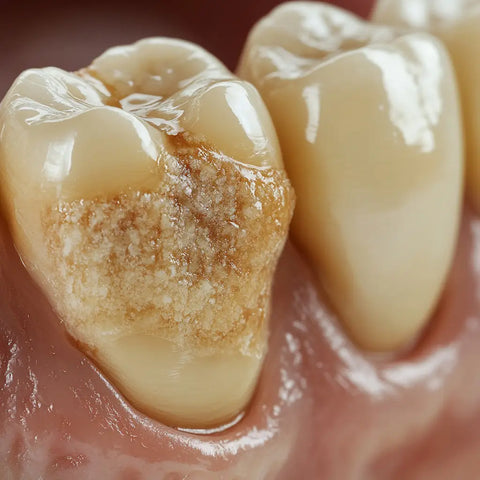What Should You Do If Something Comes Loose While You're Flossing?
If you feel something break off in your mouth while you are flossing, it can be unsettling and lead you to believe that you have chipped one of your teeth. On the other hand, there is a greater possibility that it is tartar.
A hard coating of germs and plaque that develops on teeth over time is called tartar. Tartar is also known by its other name, calculus. Only a dentist who is performing dental cleaning can remove it successfully.
What is Tartar?
Don't freak out if, when flossing, you ever have the feeling that something is coming loose within your mouth. Just continue flossing normally. It's possible that what appeared to be a chipped tooth was actually only a piece of tartar that broke off. Plaque that has been allowed to remain on the teeth for an excessive amount of time and has been allowed to get mineralized due to the presence of minerals in saliva may eventually solidify into tartar. It is possible for it to cause gum disease and tooth decay if it is not treated.
Tartar is distinct from normal tooth enamel in that it is extremely fragile and has a hue that is somewhere between yellow and brown. It has a tendency to be situated close to the gum line or in the spaces between teeth, and it may have a scratchy sensation when touched. Additionally, it may be an indication of more significant issues with oral health, such as gingivitis, tooth decay, or gum disease.
The good news is that tartar can be easily avoided if you brush your teeth at least twice a day for a total of two minutes during each session, and if you routinely clean the spaces in between your teeth with dental floss or another interdental cleaner. In addition to this, it is essential that you maintain routine visits to the dentist for checkups and cleanings.
Although it is not unusual for bits of tartar to fall off while flossing, the best approach to ensure that all of your tartar is gone is to come in for a professional cleaning and examination of your teeth. Your dental hygienist or dentist will be able to remove any particles of tartar that have become calcified and leave your teeth free of plaque, bacteria, and tartar entirely.
If you already have tartar on your teeth, it is quite difficult to remove it on your own without causing harm to your gums and teeth, thus it is best to consult a dentist. Tartar is adhered to your teeth, and the only way to remove it is to have a dental professional use a tool called a scaler to scrape it off your teeth. Tartar cannot be removed on its own. You run the risk of destroying healthy dental enamel along with the stain if you try to remove it on your own. If the bit of tooth that you believe has fallen off is truly tartar, you can determine this by applying pressure on it and observing whether or not it crumbles readily. You can also perform a straightforward taste test by chewing on the piece of tartar to determine whether or not it has a gritty or disagreeable flavor.
Why Is The Tartar Breaking Off?
You are going about your typical routine of brushing your teeth and flossing when all of a sudden you feel like a piece of something stony has broken off in your mouth. Even while the immediate reaction to this may be one of alarm, it is essential to keep in mind that the problem may not be a chipped tooth at all but rather hardened plaque or tartar. Since this might result in major issues with your oral health, it is imperative that you recognize this as a cautionary sign and make an appointment with adentist for a tooth cleaning as soon as possible.
The only way to prevent plaque and tartar from accumulating on your teeth is to floss at least once every day. Because of its adhesive nature, the hardened calcified substance cannot be removed at home with string floss or a water flosser. This makes it impossible to remove the substance. Tartar can only be removed from your teeth by a trained dental professional with the help of specialized dental tools during a routine dental cleaning appointment.
When plaque has been allowed sufficient time to develop, it will eventually transform into tartar, also known as calculus, which is a substance that has been calcified. This is a substance that is exceedingly tough to remove; it has a rough texture, and its color is most frequently a dark brown or black. It is extremely analogous to cement in that it is securely stuck to your teeth and is very difficult to remove without the assistance of a dental professional because of how closely it resembles cement.
When tartar is removed, it frequently splits into small pieces and takes on the appearance and feel of sandpaper as a result of the process. It is also possible for it to flake off while you are eating or drinking, and when it does so, it will feel like minute particles of sand are in your mouth.
Even though this may be seen as a positive sign because it suggests that the tartar is becoming more loose, it is nonetheless detrimental to the health of your gums and teeth. The gum tissue can become irritated when tartar is present, which can, over time, lead to the development of gum disease. In addition, it has the potential to erode the teeth and cause cavities.
If the calcified plaque and bacteria are allowed to remain untreated, they can cause the gum tissue, bone, and teeth to degrade, which can lead to major problems with oral health. This includes periodontal disease, which is a deep infection of the gum tissue that can cause the gums, teeth, and bone to deteriorate. Periodontal disease is one of the most common causes of tooth loss in adults. It is crucial to visit your dentist on a regular basis and practice good dental hygiene in order to prevent tartar from forming, as tartar is the primary factor in the development of periodontal disease.

How Can Tartar Break Off While Flossing?
When plaque is not removed from the teeth on a daily basis, tartar can form on the teeth. After some time, this might become brittle and transform into a rough surface, which can irritate the gum tissue. Gingivitis and other severe forms of gum disease may develop as a result of this. Tartar is porous, and because of this, germs are able to become trapped inside of it, which ultimately leads to tooth decay. In most cases, tartar can only be removed by a dentist during a professional dental cleaning. This is because tartar cannot be broken off at home.
It is common for people to believe that their tooth enamel has broken when they hear or feel something crack or break in their mouth when flossing. However, it is possible that it is simply a bit of tartar. Due to the fact that enamel and tartar are both white and firm substances, distinguishing between the two can be challenging. Examining the item in question in a careful manner is one approach to find out. If the substance is yellow or brown in color, then the likelihood is high that it is tartar rather than tooth enamel. You can also try applying light pressure to it in order to check whether it cracks. Tartar may be broken down with relatively little force, but tooth enamel requires a greater amount of force to fracture.
Flossing is an excellent method for removing any plaque that may still be present, and it can be particularly helpful in regions that brushing may miss. Getting rid of any plaque or tartar that may still be present in the mouth can also be accomplished effectively by using a water flosser. It is essential to maintain a consistent oral hygiene routine that includes the use of a toothbrush and floss, and to check that both instruments are effectively cleaning the entirety of the oral cavity.
When flossing, it is possible that a piece of tartar will come off, but this does not happen very often. If a piece of calculus is going to break off while you're flossing, it needs to meet both of the following criteria: (1) The tartar must still be in the immature phases of its development, and (2) the individual must be flossing their teeth with string rather than a water flosser. When a plaque has developed into a calculus bridge, it becomes extremely difficult to remove and can only be done so by a dentist. To avoid this, it is essential to maintain a high standard of oral hygiene at all times and to see a dentist at least once every six months for a comprehensive cleaning.
What Action Should I Take?
When flossing, if you feel something break off your teeth, it is crucial to determine whether or not the "something" was indeed tartar or a chipped tooth. Because it leaves the inner structure of the tooth vulnerable to infection and may leave a sharp area that can damage the tongue or gums, a fractured piece of tooth enamel can be quite hazardous to your oral health. On the other side, having a tooth that is chipped could allow bacteria to enter your bloodstream, which would lead to major health issues.
The good news is that it is generally fair to presume that a shattered piece of your dental work is in fact tartar. This assumption can be validated by carefully analyzing the piece in question. Tartar can seem brown, drab yellow, or even black, and it crumbles very quickly when pressed, in contrast to tooth enamel, which requires a greater amount of power to crack. Applying a very light amount of pressure with your finger is another option for evaluating the piece's texture. If the piece is firm, then it is most likely a chipped tooth, but if it crumbles, then it is likely tartar. If the piece is crumbly, then it is certainly tartar.
It is imperative that you make an appointment with your dentist as soon as possible if you have any reason to believe that pieces of tartar were dislodged while you were flossing. Your dentist will be able to remove any tartar that is still present and return your teeth to their natural state after performing this procedure. It is highly recommended that patients visit their dentist every six months for expert cleanings as this is the most effective strategy to prevent plaque from developing into tartar and avoid future tooth problems.
It is probably time for you to schedule an appointment with your dentist for expert cleanings if you've noticed that your teeth are starting to look a little yellow or have a rough texture. The good news is that tartar buildup may be easily prevented by brushing your teeth twice a day for two minutes, using dental floss or interdental cleaners to clean between your teeth on a regular basis, and rinsing your mouth with mouthwash on a regular basis. To further ensure that your teeth remain in good health, you should see a dentist at least once every six months for a checkup as well as a professional cleaning of your teeth. If you want to avoid having dental problems in the future, it is in your best interest to take some easy preventative measures now.



























































Leave a comment